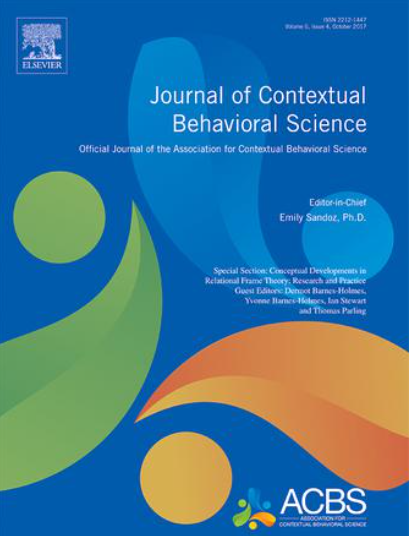Post-traumatic stress, cognitive fusion, and intolerance of uncertainty as longitudinal predictors of post-traumatic growth from the COVID-19 pandemic
IF 3
3区 心理学
Q1 PSYCHOLOGY, CLINICAL
引用次数: 0
Abstract
The COVID-19 pandemic was a significant stressor that posed threats to life and ways of living. The harmful psychological effects of the COVID-19 pandemic have been well documented, but positive psychological changes can also follow significant stressors. These changes are referred to as post-traumatic growth (PTG). The present study explored how PTG may develop from a contextual behavioral science perspective. Intolerance of uncertainty and cognitive fusion were longitudinally examined as predictors of PTG from the COVID-19 pandemic in a national United States sample. Self-report data were collected from Amazon Mechanical Turk Workers (MTurk) at three time points between April and November of 2020 as part of a larger study. Results indicated that higher levels of PTS, higher intolerance of uncertainty, and lower cognitive fusion in April 2020 each predicted greater PTG in June 2020 but did not predict change in PTG the next four months. Intolerance of uncertainty and cognitive fusion interacted to predict PTG from June to November with intolerance of uncertainty predicting more growth when cognitive fusion was high and less growth when cognitive fusion was low. Cognitive fusion and intolerance of uncertainty were thus found to be significant predictors of PTG that interacted with each other and varied as a function of time. Explanations for their involvement in the development of PTG across time are offered.
创伤后应激、认知融合和对不确定性的不耐受是COVID-19大流行创伤后成长的纵向预测因素
COVID-19 大流行是对生命和生活方式构成威胁的重大压力源。COVID-19 大流行所造成的有害心理影响已被充分记录在案,但重大压力之后也会产生积极的心理变化。这些变化被称为创伤后成长(PTG)。本研究从行为科学的角度探讨了创伤后成长是如何形成的。在美国全国样本中,对不确定性的不容忍度和认知融合作为 COVID-19 大流行的创伤后成长的预测因素进行了纵向研究。作为一项大型研究的一部分,我们在 2020 年 4 月至 11 月期间的三个时间点收集了亚马逊机械特克工人(MTurk)的自我报告数据。结果表明,2020 年 4 月较高的 PTS 水平、较高的不确定性不容忍度和较低的认知融合度均可预测 2020 年 6 月较高的 PTG,但不能预测接下来四个月 PTG 的变化。不确定性不容忍度和认知融合度相互作用,预测了 6 月至 11 月的 PTG,其中不确定性不容忍度预测了认知融合度高时的增长,而认知融合度低时的增长。因此,我们发现认知融合和不确定性不容忍度是预测 PTG 的重要因素,它们相互影响,并随时间而变化。本文对它们参与 PTG 跨时间发展的原因进行了解释。
本文章由计算机程序翻译,如有差异,请以英文原文为准。
求助全文
约1分钟内获得全文
求助全文
来源期刊

Journal of Contextual Behavioral Science
PSYCHOLOGY, CLINICAL-
CiteScore
8.50
自引率
18.00%
发文量
82
审稿时长
61 days
期刊介绍:
The Journal of Contextual Behavioral Science is the official journal of the Association for Contextual Behavioral Science (ACBS).
Contextual Behavioral Science is a systematic and pragmatic approach to the understanding of behavior, the solution of human problems, and the promotion of human growth and development. Contextual Behavioral Science uses functional principles and theories to analyze and modify action embedded in its historical and situational context. The goal is to predict and influence behavior, with precision, scope, and depth, across all behavioral domains and all levels of analysis, so as to help create a behavioral science that is more adequate to the challenge of the human condition.
 求助内容:
求助内容: 应助结果提醒方式:
应助结果提醒方式:


